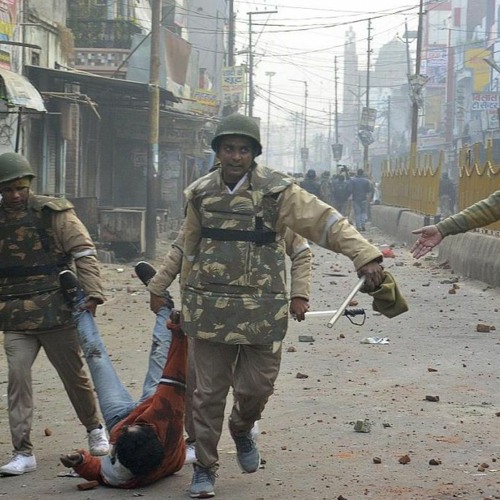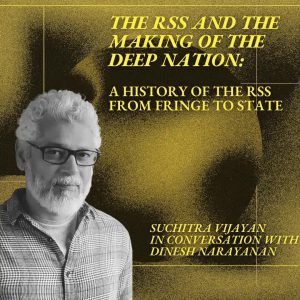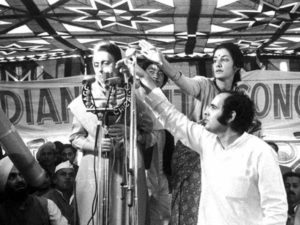
All of this has only increased people’s fear and mistrust especially because many of these riots have actually seen the armed forces being used to deal with such situations without any checks and balances and they have resorted to a whole range of brutalities and atrocities. Now, this history is going to have a very long-lasting impact. And as we went into the field, we could see a lot of anger amongst people. People were clearly pointing to the fact that some of the boys, for instance, were kept in a farmhouse run by a BJP MLA. They were pointing to the fact that UP has a concept of police mitras. Now police mitras are like the civil defence police so they are civilians but who are given recognition by the police to assist them. They also act as informers for the police. Largely these police mitras are from the Hindu community and many of them are Brahmin. So, many of the police mitras were used this time to deal with the protests. And they were the ones who were given batons and were let loose on the protestors. One, of course, is the history, two is the use of armed forces against people to unleash violence and three now is also the use of civilians which is a cause for worry.
Given the long history of violence, do you feel that there is a way forward in terms of even finding legal and judicial redress for this crisis?
BA: Given that there is already a petition in the Allahabad High Court and it hasn’t been dismissed yet, one is hopeful that this one will also be heard and considering that we, fortunately, have a recent order from the Supreme Court of India asking what was the juvenile justice system doing at such times and why did they not come into action? I think that gives us a positive way forward. Because this is about children – today the CAA NRC protests, tomorrow it could be something else. We are seeing this in Assam as well. The impact of the NRC on children in Assam is equally grave. So, it has to be seen in that light and probably addressed in that light. Series of violations of children’s rights particularly the Juvenile Justice Law and the failure of the child protection system to act at such times.
We have the National Disaster Management Authority which has a policy on dealing with both man-made and natural disasters. But it is so unfortunate that it does not look at the need for activating child protection systems in such situations, considering these are situations that do not only end up in violence against children but also end up in a series of exploitation of children in different ways ranging from increase in the number of child labour to trafficking, to a whole range of other forms of exploitation. We want to focus on the fact that these are situations where children’s rights need to be taken care of and systems need to get activated. They cannot take the plea that we were waiting for information. It is sad that despite this report being released in public, neither the NCPCR (National Commission for Protection of Child Rights) nor the NHRC (National Human Rights Commission) has taken suo moto cognizance which is well within their powers. That is probably one of the reasons why we will have to go to court.
In fact, quite disappointingly NCPCR, as per our report issued a notice to UP Police where they actually handed impunity over to the Police and asked to go out and make sure that there are no child protestors and that there are no children being used as human shields. And at no point does the NCPCR direct the Police to look at JJ Act or think about what would you do when you have a child protestor because children also have protesting rights. You can’t just arrest them and say: you are not allowed to protest. NCPCR, which is supposed to be securing the rights of children, in fact, has handed impunity to the Police and said to go ahead and detain these children. So, it’s a bit ironic that we are dealing with independent child rights bodies and asking them to do their jobs.
Nidhi, could you lay out the various patterns of state violence that this report documents?
NS: When we started recording testimonies, we realized that the range of torture is not just physical but also psychological and emotional in nature. We have divided it into seven methods of torture used by the UP police. One is, of course, physical violence where children were beaten with police batons, lathis, stripped. We have a 15-year-old child in Muzaffarnagar saying that he constantly kept telling the Police that he was also physically challenged but today he has a fractured hand because of the torture inflicted by the police. Two, there was torture by sleep deprivation. A lot of the children testified that they were not allowed to fall asleep and that every time they fell asleep, they were beaten up. Three, some of them were not given drinking water when they asked for water or they were given water and not allowed to use the toilet when they really needed to urinate and instead were beaten up. And four, they were intimidated – heavy intimidation happened. Some of them were forced to watch videos of adults being beaten up and told that this is what will happen to you. A lot of them when they were released, they said that the Police held them and said: “Don’t ever think that you will go to another protest because this is what will happen to you.” We must also keep in mind that most of the children who were detained were Muslims and they were forced then to chant Jai Shree Ram and there was a lot of xenophobic abuse that was hurled at them. The fifth is, they were made to witness adult violence. So as per JJ Act, you are not even allowed to keep children and adults in the same lock-up but these children were not only kept in the same lock-up, but also made to watch adults being tortured by the Police. And sixth, there was a lot of public humiliation; the wanted posters had minors’ faces revealed. They were under direct threat. A lot of parents had to send their young boys out of the village as Bharti Ji said. Seven is torture by silencing. In Muzaffarnagar, when they were releasing the children they asked their guardians or adults or sometimes even the children to sign an affidavit under duress saying that there was no torture and that nothing happened to them. And this is just the immediate physical and emotional violence.
A lot of the times in such situations the very definition of torture can be quite limiting because after the release, even after a certain amount of post-custodial intimidation and torture, the children in UP were met with a lot of silence from the State and child rights organizations. This silence, the way I see it, is also torture. You have completely dehumanized and eliminated them from your line of vision and that itself, the lack of condemnation itself, can be torture. While it is difficult to quantify this torture we do have enough evidence to take it to court. But I think it is very important to bear in mind that while it’s important that courts take notice and issue compensation, we really have to ask ourselves if judicial justice is enough to offer closure to these children. We are at a point where we really have to step back and ask why is this even happening in the first place? I mean we are struggling to put in mechanisms to deal with it, but maybe the question to ask is what is it about that UP Police, Police as a group of human beings, who seem to completely disengage with their sense of compassion or conscience when they come to torturing young children in such a merciless way. So, for us this report has raised a lot of larger questions. One on the silence. One on why this is even happening. You know I think that’s the question we have to look at because this justice even if the court takes notice is it going to become closure because you have scarred a child for life in many ways.
There seems to be a large pattern of silence as well, why do you think that is?
NS: The State knows what it is doing. It’s inducing so much fear among the children, and the families. Even if we move towards advocacy, we also really have to question ourselves on how do we petition, whose name do we put out there, how much intimidation are we going to get? Because we have to understand that the State doesn’t work as State alone, they have enough fringe groups whether it is the ABVP (Akhil Bharatiya Vidyarthi Parishad is a right-wing all India student organisation affiliated to the Hindu nationalist Rashtriya Swayamsevak Sangh) or RSS (Rashtriya Swayamsevak Sangh, an Indian right-wing, Hindu nationalist, paramilitary volunteer organisation.) or Bajrang Dal, who seem to work with so much impunity and seem to be not hold accountable for any of the violence that they inflict and clearly there is a lot of State support that they have. So, all of us, whether it be child rights organizations or people on the field, there seems to be a constant fear, constant paranoia as to when is the next attack going to happen. And it’s very clear, even if you look at the case of Sharjeel Imam. They were able to hunt him down from all the way in Bihar. And in the JNU attacks they have recognized the woman Komal Sharma and they seem to say that they can’t find her. I don’t even think that the State is trying to be subtle in letting us know where they stand and who they intend to attack. So, we are all having to be cautious because while everything looks normal, we are going on with our daily lives, we don’t know when things would change and at what point it would all affect us directly.
And now, I want to talk about the necropolitics of what happens after violence. Bharti ji could you talk about how this violence has affected the social life of the Muslim community? Would you argue that this has caused perhaps a civil death amongst the Muslim community?
BA: A lot of boys were asked to leave because of fear of getting arrested. So, you can imagine the way it has disrupted social life in general, also relationships and families in particular. What I would definitely say is that there have been reports in the past, for instance, the Justice Sachar Committee report that specifically focused on the exclusion of minorities, Muslim minorities and also talked about the magnitude and extent of denial of both civil and political rights and economic and social and cultural rights. So there has been a systematic effort to eliminate communities based on their faith and the religion they follow. Always we have seen that some kind of fear around the Muslim community has been created with a campaign which says: oh, they have multiple wives. Oh, they do not have family planning. They have so many children. Oh, they are just rising in numbers and each time evidence is produced to the contrary, but the State chooses to overlook that evidence. That has had a long-lasting impact in the minds of people and created a divide which has reached a scale where even normal conversation around the rights of Muslim people or community is not possible anymore.
So, in social life it’s denial and violation of rights, which is only going to increase in the years to come. We don’t stand up for the community is something that I want to insist on and in this backdrop the rights of children of these communities are particularly at stake. We have noticed that a lot of children who come in conflict with the law belong to certain kind caste and religious minorities, particularly Muslims. And, at one point, our crime records used to give us statistics on the ethnicity and the caste of the children and others who are coming in conflict with the law, which they have stopped giving now. I can’t give you numbers but because we deal with them directly, we know that a lot of them are from the Muslim community. And every day they make stringent laws on the grounds that increasing number of children are committing crimes, they are actually trying to say that an increasing number of Muslim children is committing crimes and therefore we need to punish them and therefore we need to make stringent laws.
As far as your question about the civil death amongst the Muslim community is concerned, I think it is, like I said, leading to the elimination of the community and denying them all the rights. Lots of children who were illegally detained had to miss out on school. Many of them I am sure will not be able to sit for their exams given the trauma they faced. So, there is that kind of disruption also in people’s lives, in the lives of children particularly. We need to look at the whole gamut of things and the worse that I am witnessing now is that even compassion has become discriminatory. I guess we just need to keep talking more. We just need to keep highlighting more and we need to encourage the voices that are actually standing up to say that we will not allow the democratic and secular fabric of the Constitution of India to be broken in this manner. Shaheen Bagh protest or similar protests across the country today need to be backed up. These protests are protests where local women have come out and they find it easier to have it near their homes rather than being taken to place like India Gate to say: oh this is the cordoned off area where you can protest or this is the only area, you know where you can, have your protests.
So, are we then killing the voices? Are we killing the voices of dissent? You know all these years we have seen attacks on individuals who were having a voice of dissent. Now we are seeing attacks on communities per se who are having a voice of dissent. So that’s where we are.
How do communities who receive such disproportionate and indiscriminate kind of violence counter such acts?
BA: Lately they have their own gatherings where they meet and discuss, but I do feel the need for a larger number of people to reach out to them, to tell them that we are with you and to build that trust. At the moment I think we are losing out on trust and they don’t know who is actually going to be standing with them when their child is being picked up or somebody is being picked up and beaten up. So that faith needs to be restored. I was trying to follow up cases of boys in Delhi who were also illegally detained during the Daryaganj protest and one of the boys I spoke with on the phone said that he doesn’t want anything from us. The parents also said that: “Look our boy is back and we are just happy with that, we don’t want anything more. We don’t want any more trouble. None of you is going to be with us when it happens next time.” So, that’s where it is today.
Bharti Ji and Nidhi, thank you so much for joining us. I was wondering if you had any concluding thoughts that we can end this conversation with and what our readers should take away from this report?
NS: One is also the question of resistance at this point. At least for us, it has become a question of solidarity. How can we express solidarity? How do we come together? How do we not allow compassion fatigue to take over, as Bharti Ji said? And with the minors report, it has been one of the most heartbreaking reports I have looked at. It’s very difficult to be hopeful. We were actually just talking about it today — Bharti Ji and I because it has taken us a lot to get the media to respond to this. It has taken us a lot, we are still working on how do we get a petitioner, when do we petition, who will petition? So, in terms of hope, it is becoming a bit difficult to hold on to it but then again this is not a time to lose hope. We are all trying to find strength in hanging in there and pushing the same systems that are failing us to work and wake up. And some days it is a bit like banging our heads on the wall. But I think it would really help if people didn’t just sit back and say yeah it is happening. Yes, I read the report over breakfast or I read this news story while going to work but actually talking about it with each other. Just spreading the information at this point seems to be the most important aspect of all and ironically, we say that at a time when we have enough resources to spread information and make ourselves aware of what’s happening.
BA: I hope that when we go to the court the petition doesn’t get dismissed and there is a hearing. We hope there is a judicial inquiry into the whole issue and more data is made available on the number of children who were detained illegally. We also hope that they are compensated for being detained illegally because it’s a serious violation, and the political scenario will change as people come out in large numbers and express their dissent. One just needs to keep building that environment. One needs support from the media more than ever before to build that environment.
You can read the entire report, Brutalizing Innocence: Detention Torture & Criminalization of Minors by UP Police to Quell Anti-CAA Protests here
*This podcast was transcribed by Preetika Nanda.











